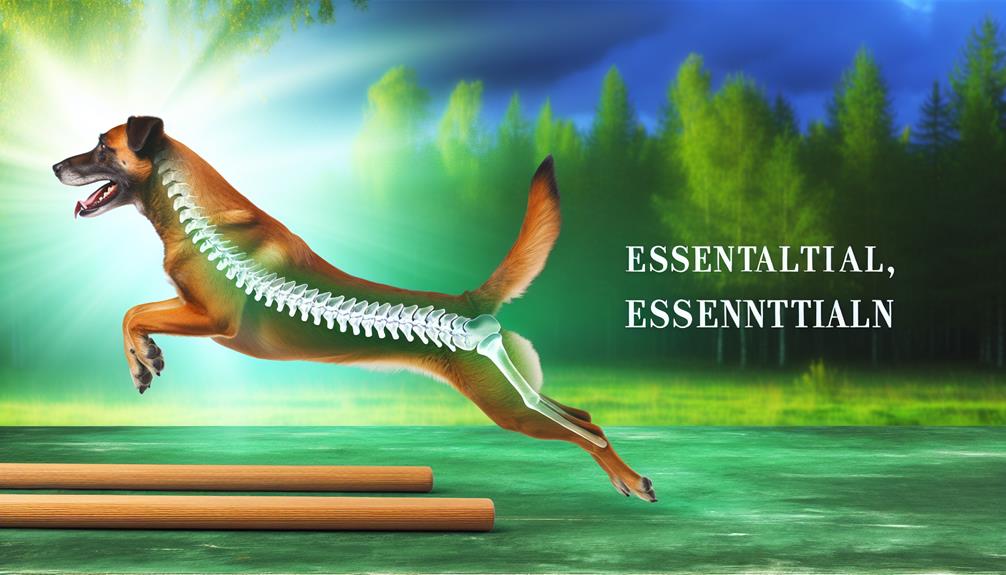
13 Feb The Ultimate Guide to Canine Spinal Health
Delve into the depths of canine spinal health and discover the secrets to maintaining your four-legged friend's well-being. From understanding the intricate anatomy of their spine to uncovering common causes of spinal issues, this ultimate guide provides a holistic approach to caring for your canine companion.
Gain insightful knowledge on the importance of mobility, tips for maintaining healthy discs, and identifying signs of back pain. But that's not all. Stay tuned for expert advice on prevention, treatment options, and the crucial role healthcare professionals play in ensuring your dog's optimal spinal health.
Get ready to embark on a journey that will leave you equipped with the knowledge and tools to keep your furry friend's spine in tip-top shape.
Understanding Canine Spinal Anatomy
To better understand the health and well-being of your canine companion, it's important to delve into the intricate and fascinating world of canine spinal anatomy. The spine of a dog is composed of a series of vertebrae, discs, and nerves that work together to facilitate movement, sensation, and flexibility.
The vertebrae serve as the building blocks of the spine, protecting the delicate spinal cord that runs through them. They also provide the necessary flexibility for your dog to perform a wide range of movements, from running and jumping to stretching and bending.
Between each vertebra, there are discs that act as shock absorbers, preventing back pain and allowing for smooth movement. These discs lack blood vessels, relying on nearby tissues for nutrition and oxygen supply.
The nerves in the spinal cord are responsible for transmitting signals between the brain and the rest of the body. They play a crucial role in coordinating movement, ensuring proper muscle function, and maintaining overall well-being.
However, certain conditions, such as Intervertebral Disc Disease (IVDD), can affect the health and function of the canine spine. IVDD occurs when the discs between the vertebrae degenerate or herniate, causing pain, mobility issues, and even paralysis.
Common Causes of Canine Spinal Issues
Common causes of canine spinal issues include intervertebral disc disease (IVDD), degenerative diseases, traumatic injuries, genetic predisposition, environmental factors, inflammatory and infectious diseases, aging, wear-and-tear, and neurological conditions.
Among these causes, IVDD is a common spinal issue that affects many dogs, especially chondrodystrophic breeds like dachshunds and French bulldogs. Their genetic makeup makes them more prone to developing IVDD. Environmental factors such as obesity and poor nutrition can also contribute to spinal problems in dogs.
Excessive jumping and physical trauma can put additional stress on the spine, leading to injuries. Inflammatory and infectious diseases, such as meningitis and diskospondylitis, can cause spinal issues as well.
As dogs age, their spines naturally undergo wear-and-tear, making them more susceptible to spinal problems. Additionally, certain neurological conditions like degenerative myelopathy can affect the spinal cord and lead to mobility issues.
It's important to be aware of these common causes and take preventative measures to promote spinal health in your canine companion.
Importance of Mobility for Spinal Health
Regular physical activity is vital for maintaining optimal spinal health in dogs. When it comes to canine spinal health, mobility plays a crucial role. Here's why:
- Disc health: Regular movement ensures that the spinal discs receive the necessary nutrition through the imbibition process. This process, similar to a sponge absorbing water, allows the discs to stay hydrated and prevents stiffness.
- Spinal flexibility: Physical activity promotes spinal flexibility, preventing the spine from becoming rigid and limiting mobility. This flexibility is essential for dogs to move comfortably and avoid strain on their spine.
- Muscle strength: Engaging in regular physical activity helps strengthen the muscles that support the spine. Strong muscles provide better stability and can help prevent spinal issues caused by weak or imbalanced muscles.
- Circulation and spinal fluid: Adequate movement ensures proper circulation of spinal fluid, which helps nourish the spinal tissues and maintain overall spinal health. Good circulation also aids in the removal of waste products from the spine, promoting a healthy environment for the spine to function optimally.
Maintaining Healthy Discs in Dogs
To maintain healthy discs in your dog, it's important to focus on disc nutrition and hydration.
By ensuring proper movement and exercise, you can prevent disc degeneration and promote optimal spinal health.
Additionally, strengthening your dog's core muscles can provide support and stability to the discs, reducing the risk of disc-related issues.
Disc Nutrition and Hydration
Maintaining healthy discs in dogs relies on proper nutrition and hydration, as their lack of blood vessels necessitates fluid absorption through movement. Here are some key factors to consider for disc nutrition and hydration:
- Discs in dogs absorb nutrients and fluids through an imbibition process during movement, similar to a sponge soaking up water.
- Adequate hydration of spinal discs through motion helps prevent degeneration, maintain flexibility, and support overall spinal health.
- Lack of movement can lead to poor disc nutrition, impairing their ability to absorb nutrients and increasing the risk of back problems.
- Ensuring sufficient mobility and hydration for spinal discs is crucial for preventing conditions like Intervertebral Disc Disease (IVDD) and promoting long-term spinal health in dogs.
Preventing Disc Degeneration
Proactively preventing disc degeneration and maintaining healthy discs in dogs requires focused attention on their overall spinal health. Regular exercise and movement are essential in promoting proper disc nutrition and preventing degeneration. Dogs' discs lack blood vessels, relying on movement to bring in nutrients and remove waste products.
By incorporating exercise into your dog's routine, you can support their disc health. Additionally, maintaining a balanced diet and managing your dog's weight can reduce strain on their spine, supporting healthy discs and preventing degeneration.
Providing orthopedic beds or supportive surfaces for your furry friend can also alleviate pressure on their discs, contributing to their overall health and longevity. Consulting with veterinarians to create tailored care plans ensures proactive measures are taken to prevent disc degeneration and maintain spinal health in dogs.
Take these steps to give your canine companion the best chance at a healthy spine.
Strengthening Core Muscles
By incorporating targeted core strengthening exercises into your dog's routine, you can effectively support their spine and maintain healthy discs. Strong core muscles are essential for your dog's overall spinal health.
Here are some key benefits of strengthening your dog's core:
- Improved stability: Core exercises help reduce the risk of spinal injuries and disc degeneration by improving stability.
- Enhanced posture: Strong core muscles provide better posture, reducing strain on the spine and promoting overall spinal health.
- Increased flexibility, agility, and coordination: Regular core strengthening routines can enhance your dog's flexibility, agility, and coordination, supporting their spine's well-being.
- Specific exercises: Incorporating balance exercises and controlled movements can target the core muscles and benefit disc health in canines.
Signs of Back Pain in Dogs
You need to be aware of the signs that your dog may be experiencing back pain.
Reluctance to move, changes in gait, and vocalizations when touched in certain areas are all indicators that your dog may be in discomfort.
Additionally, behavioral changes such as aggression, restlessness, or decreased activity can also signal underlying back pain.
Recognizing Back Pain
Recognizing back pain in dogs can be crucial for ensuring their spinal health, as it may manifest through various signs and symptoms. Here are some key signs to look out for:
- Reluctance to move: If your dog is avoiding physical activities or is hesitant to walk or run, it could be a sign of back pain.
- Vocalization: Yelping or whimpering when touched, especially in the back area, is a common indication of discomfort.
- Changes in posture: A hunched back or an altered stance can be a sign that your dog is experiencing back pain.
- Reduced activity levels: If your dog seems less energetic or is showing a decrease in playfulness, it may be due to back pain.
It's important to remember that recognizing these signs doesn't replace a veterinary consultation. If you notice any of these signs, it's best to seek professional advice to ensure your dog's spinal health.
Behavioral Changes
If your furry companion is exhibiting behavioral changes, it could be a sign that they're experiencing back pain.
Dogs may show sensitivity to touch along the spine, muscle spasms, and gait abnormalities. They may also display reluctance to move, yelping or whimpering when touched, and posture changes like a hunched back.
Reduced activity levels, difficulty getting up or lying down, and avoiding stairs or jumping are other signs to watch out for. Some dogs may even become aggressive when approached or handled due to the pain they're experiencing.
It's important to monitor any sudden or unexplained shifts in your dog's behavior, as they may indicate underlying back problems that require veterinary care.
Preventing Spinal Problems in Canines
Regular exercise and a balanced diet are key factors in preventing spinal problems in canines. By incorporating these practices into your dog's daily routine, you can promote their overall spinal health and well-being. Here are some essential tips to help you prevent spinal issues in your furry friend:
- Exercise: Engaging your dog in regular physical activity helps maintain muscle strength and flexibility, supporting a healthy spine.
- Balanced diet: Providing a nutritious and balanced diet is crucial for managing weight, reducing strain on the spine, and lowering the risk of spinal problems.
- Orthopedic beds: Investing in orthopedic beds or supportive surfaces can provide your dog with proper spinal alignment and comfort while resting or sleeping.
- Consult veterinarians: Regular check-ups and consultations with veterinarians are essential for developing tailored spine care plans for your dog, ensuring proactive prevention measures.
Remember that early detection, intervention, and monitoring are crucial aspects of preventing serious spine problems. Stay vigilant for any signs of discomfort or changes in your dog's mobility, and seek professional advice promptly. By prioritizing prevention and taking proactive measures, you can help your canine companion maintain a healthy spine and overall well-being.
Treatment Options for Canine Spinal Issues
Treatment options for canine spinal issues encompass a range of interventions, including medications, surgery, physical therapy, and rehabilitation, depending on the specific condition and the dog's response to therapy.
When it comes to back care and spinal health in dogs, it's essential to have a holistic approach that takes into account the individual needs of each dog. Medications can be used to manage pain and inflammation, providing relief and improving the dog's comfort and mobility.
In more severe cases, surgery may be necessary to alleviate pressure on the spinal cord and nerves, addressing conditions like intervertebral disc disease (IVDD). Physical therapy and rehabilitation play a crucial role in strengthening muscles, improving range of motion, and supporting overall spinal health. These therapies may include exercises, massage, hydrotherapy, and other modalities tailored to each dog's specific needs.
It's important to create a customized treatment plan based on the specific condition and the dog's response to therapy. By considering all available treatment options and collaborating with veterinarians and specialists, you can ensure the best care and outcomes for your dog's spinal health.








No Comments